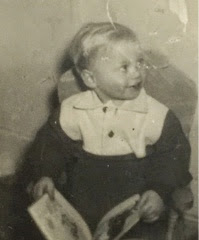Rick's great grandfather, James, (Jim) Smith, was born in 1869 in Dildo, Newfoundland to Eliol Smith* and Catherine Moore Smith. He married Sarah Reid and they eventually moved across Trinity Bay to Old Shop where Jim established a saw mill. He needed workers for the saw mill and the workforce was more stable if the men had their families with them. Therefore Jim opened a store to provide for the needs of the families of Old Shop. His saw mill cut all the wood for the church or school in the community. Jim also owned the first car in the town.
Jim and Sarah had nine children:
Andrew, born 1899, married Flossie Dooley, eventually lived in Mt. Pearl, Newfoundland.
Ernest, born 1901, married Bessie Earle in Corner Brook, Newfoundland.
Katherine, (Katie), born 1904, worked for a time at Corner Brook House, the home of the mill manager. She was a seamstress and married John McRae. They lived in Dundas, Ontario.
Rose, born 1906, married Ambrose Hutchings of Whitbourne, Newfoundland.
Emmie, born 1909, married Duncan Dewar and lived in Prescott, Ontario.
Fred, born 1911, died of diphtheria as a child.
Mary, born 1913, died of breast cancer in St. John's, Newfoundland.
Lewis, born 1915, died of diphtheria as a child.
John, born 1917, died of diphtheria as a child.
John and Fred's headstone
The Smiths lost three of their youngest boys, Fred, Lewis and John within a year of each other. It must have devastated the family to lose three of their children and within such a short time. The grief is unimaginable.
Eventually Jim and Sarah moved to Corner Brook when the paper mill was establishing there in the 1920s. Jim was a carpenter, helping with the construction of the mill. Jim and Sarah were in Corner Brook when their son, Ernest married Bessie Earle of Durrells in 1925. Ern and Bessie lived with Jim, Sarah and the family when they first married. The elder Smiths lived at 5 East Avenue, a house which is still there today.
Jim moved his family back to Old Shop when Sarah became ill.
Jim Smith, Minnie (second wife), Dale, great grandson
After she died, he eventually married Minnie who is in the picture with Jim's great grandson, Dale. Dale's father is Gordon who is son of Andrew, Jim's oldest son.
Sarah and Jim Smith are buried in Old Shop.
*Eliol Smith was born and lived in a winter tilt. In the summer, the fishermen and their families lived in exposed areas along the coast of Newfoundland while they fished. In October, they moved to more protected areas, often further inland where they constructed their winter homes. The winter tilts were built where wood was more readily available for home construction but also for firewood. The homes were made of logs, seams filled with moss or bark, sod roofs.The stone fireplace provided for heating and cooking and a hole in the roof allowed the smoke to exit.
Great Great Grandmother Catherine Smith
Catherine Moore Smith is buried in Dildo, Newfoundland. We suspect that Eliol is buried next to her in an unmarked grave.
Thank you to Aunt Marie Smith for all of your help with the family history.
Please feel free to add comments or questions to this or any story on the blog.


















































